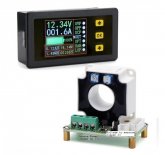SCClockDr
Solar Enthusiast
I've been fiddling with 2 Drok Hall Effect DC power monitors.
- DROK DC 0-300V 200A STN LCD Display Digital Multimeter (01)
- DROK DC Voltmeter Ammeter, 0-90V 100A Digital Voltage Current Capacity AH WH Power Time Multimeter (02)
Meter 01
Retains the cumulative Data regardless of power interruptions.
Will track negative results to the maximum digital capacity of the display.
The meter will display current with the current wire passing through the coil in either direction.
Back light needs to be manually controlled.
Is capable of using battery voltage for power while monitoring a different voltage that corresponds with the amperage being recorded.
Does NOT have a clock display.
Meter 02Retains the cumulative Data regardless of power interruptions.
Will NOT track negative results below zero, it will count down a positive result till it reaches zero though.
The meter will NOT display current with the current wire passing through the coil in a direction resulting in negative result.
Back light internally controlled. Edit: Back light can be forced on/off as well.
Is capable of using battery voltage for power while monitoring a different voltage that corresponds with the amperage being recorded.
Does have a clock display that reflects the duration of the sampling period.
So based on these findings meter 01 seems best suited to monitor battery current & is equally suited to monitor other currents provided no clock data is needed. Meter 02 is best suited for monitoring unidirectional currents like PV, SCC out, battery charger, or Load. The image shows the sources that are needed to operate meter 02 sampling a different voltage from its power source.
Attachments
Last edited:




